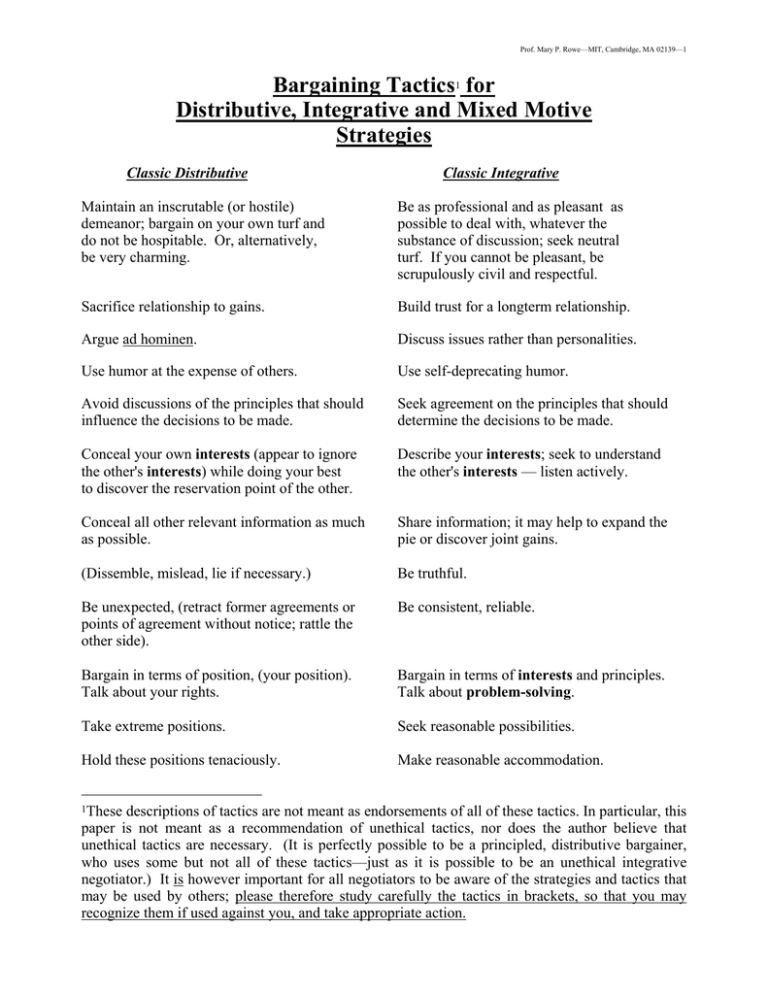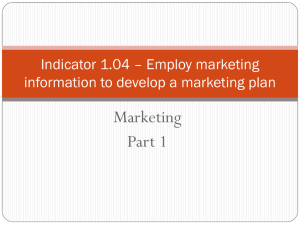Bargaining Tactics for Distributive, Integrative and Mixed Motive Strategies
advertisement

Prof. Mary P. Rowe—MIT, Cambridge, MA 02139—1 Bargaining Tactics1 for Distributive, Integrative and Mixed Motive Strategies Classic Distributive Classic Integrative Maintain an inscrutable (or hostile) demeanor; bargain on your own turf and do not be hospitable. Or, alternatively, be very charming. Be as professional and as pleasant as possible to deal with, whatever the substance of discussion; seek neutral turf. If you cannot be pleasant, be scrupulously civil and respectful. Sacrifice relationship to gains. Build trust for a longterm relationship. Argue ad hominen. Discuss issues rather than personalities. Use humor at the expense of others. Use self-deprecating humor. Avoid discussions of the principles that should influence the decisions to be made. Seek agreement on the principles that should determine the decisions to be made. Conceal your own interests (appear to ignore the other's interests) while doing your best to discover the reservation point of the other. Describe your interests; seek to understand the other's interests — listen actively. Conceal all other relevant information as much as possible. Share information; it may help to expand the pie or discover joint gains. (Dissemble, mislead, lie if necessary.) Be truthful. Be unexpected, (retract former agreements or points of agreement without notice; rattle the other side). Be consistent, reliable. Bargain in terms of position, (your position). Talk about your rights. Bargain in terms of interests and principles. Talk about problem-solving. Take extreme positions. Seek reasonable possibilities. Hold these positions tenaciously. Make reasonable accommodation. 1These descriptions of tactics are not meant as endorsements of all of these tactics. In particular, this paper is not meant as a recommendation of unethical tactics, nor does the author believe that unethical tactics are necessary. (It is perfectly possible to be a principled, distributive bargainer, who uses some but not all of these tactics—just as it is possible to be an unethical integrative negotiator.) It is however important for all negotiators to be aware of the strategies and tactics that may be used by others; please therefore study carefully the tactics in brackets, so that you may recognize them if used against you, and take appropriate action. Prof. Mary P. Rowe—MIT, Cambridge, MA 02139—2 Give in only a little, and only if forced. Offer accommodation on occasion; make larger concessions if warranted. Widen the agenda so you will have bargaining chips you do not care about, to give up. Narrow the agenda to what's important, or seek other possible gains for the other side, as well as your own, by expanding the pie and/or constructing a "package". Set deadlines; create tension; repeat demands; (push decisions through before the other side can assess the implications; conceal negative consequences of the decision for the other side). Take as much time as you need; take time out; be sure the other side really understands the consequences of the decision and accepts them. Don't let anyone else in on anything if possible, except as below. Brainstorm with as many wise heads as possible. Generate more options. Refer all final decisions to another unknown, or higher authority, (who may even renege if necessary). Let the real decision-maker bargain directly. Tactics Common to All Strategies Forestall commitment by the other side to the other's initial position. Help the other side save face, if they do not or can not attain a position they've taken, and especially if they move their position. Help both sides to come to feel that whatever settlement is reached, that it is the best possible one under the circumstances. Mixed Motive Strategies In almost all negotiating situations you will have "mixed motives," where you wish both to create value with your Other, and then to claim your share. In these situations you may use tactics common to both strategies, or switch at least a little from one strategy to the other. For example one would show respect at all times, be cautiously forthcoming about one's interests, share information as trust grows, be truthful and consistent, seek common ground and agreement on principle, generate as many options as possible, and in general pursue the integrative path as long as possible, while explicitly safeguarding your own interests. In many situations you will be able to expand the pie before having to divide it. These ideas are drawn from the experience of the author and from Walton & McKersie, A Behavioral Theory of Labor Negotiations, McGraw-Hill, 1965. They also owe much to the work of Roger Fisher and of William Ury.




